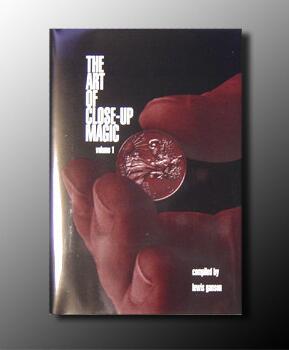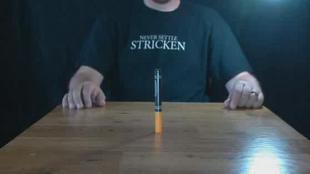My Account
This product was successfully added to cart!
The Art of Close Up Magic Vol 1 by Lewis Ganson
 Shipping: International shipping available
Shipping: International shipping available Shipping time: Instand download
Shipping time: Instand download Discount: Purchase more than $20 and get automatically 20% discount on checkout (more than $4.99 for 10%, $15 for 15% discount on checkout)
Discount: Purchase more than $20 and get automatically 20% discount on checkout (more than $4.99 for 10%, $15 for 15% discount on checkout) Handling time: Send within 1 business days after receiving cleared payment
Handling time: Send within 1 business days after receiving cleared payment Returns: 7 days money back guaratee
Returns: 7 days money back guaratee
Product Detail
IMPORTANT! READ THIS FIRST
Shipping Guide
Sending Time
Product Tags
Lewis Ganson – The Art of Close Up Magic Volume 1
Comments (magicref): Well written close up magic by many contributors. There is no card magic in the bunch except as props. Each effect is well thought out and fully described with lots of practical advice. Each effect has been worked so that it can be performed. Some of the effects are performed using magic props that are available from dealers, most don't need anything special. In a few cases I'm not sure if the props are still available. Clear line drawing are provided where needed. Some of my favorites include: 53-85 Okito Box effects; 87 Loop Chain; 103 Shell Game (need walnuts); 113 Purse Swindle (need 3 purses); 118 Phoenix Pound: load folded dollar into envelope; 131 Paddles; 150 Color Change Knives; 174 Dual Control Pencil; 195 Ringer ring on wand/linking ring effect; 200 Thimble box: magnet/nesting thimbles; 208-231 Coins alone; 232 Cylinder & Coins (pivoting stack); 282 Imp Bottle; 316 Gozinta Pencils; 324 3 Little Pigs; 335 Beer Mats & Coin; 344 Sponge Ball Routine; 354 Chinese Bowl: Benson Bowl type. See Bruce Elliot's Classic Secrets of Magic; 369 Jardine Ellis Ring
Contents: (The short descriptions below do not to justice to the magic contained here.)
Preface: Foreword by Fred Lowe
1 Chapter 1 – The Presentation of Close-Up Magic: essay on the presentation of magic
1 Introduction: presentation style varies depending on the size of the group
3 One Spectator
6 A Small Group
10 The Large Group
11 Containers: carrying and storing magic props
15 Working Surface: table surface, dice stacking
16 Music: Music, players, and a suggestion for a comedy bit
21 Close-Up Effects: choosing effects with a plot
22 Length of Performance: suggestions
24 Practice: suggestions
26 Economy of Movement: improving your performance
29 Borrowing: to borrow or not to borrow from the audience; also some suggestions on examination of objects
34 Chapter 2: Bangle Dangle: Presents ring and rope or silk routines.
34 Bangle Delight (Frederica and Rink): A ring becomes threaded on a rope and is subsequently magically removed. Uses a 36" length of rope and a bracelet sized ring
39 The Traveling Ring (Raymond Hafler): Ring jumps from knot to knot on a rope. Same props as above.
42 Ring Transposition (Glen Gravett): A red ring on a yellow ribbon and a yellow ring on a red ribbon switch places under a handkerchief. Uses bracelet sized rings, 38-42" ribbons, and a handkerchief.
47 Two Rings and a Silk (Glen Gravett): A yellow and red ring are tied on a silk. The ring selected by a spectator is instantly removed. Uses just two bracelet sized rings and a silk.
50 Ring, Rope, & Silks (Ravelle and Andree): Silks are tied to a rope and ring. The center of the rope is dropped into a hat, and the ring is dropped in. The ring is pulled out, and is linked to the rope!
53 Chapter 3: Boxes and Brass: Okito style coin box routines. Describes German Box, Okito Box, Boston Box, and Brass Coin Cap
54 German Box Routine (Jack Ganson): Six coins in box are held in a handkerchief. The coins penetrate both the box and the handkerchief and drop into the spectators hand. The box is shown empty. Uses a German Box with implanted English Penny.
59 Coins Through (Jack Ganson): As above (with a German Box), but the coins go through the table top.
60 Tea for Two (Ken Brooke): German box filled with coins is covered by a tea cup. After some byplay, the coins travel to underneath a second tea cup.
62 Okito Box Routine (Ken Brooke): Full Okito box routine using 2 coins and a box of cigarettes. Presents the "master move" as performed by Ken Brooke. Could substitute a box of cards for the cigarette pack.
72 Boston Three Step (Fred Lowe): Six English pennies and a smaller coin are placed in a Boston Box. The small coin penetrates them all, then re-appears back on top. Finally, all the coins penetrate.
80 The New Pocket Coin Trick (John Ramsay): A brass cap is placed over three coins. One coin penetrates the hand. Uses a specially gimmicked brass coin cover.
86 Chapter 4: It's a Gamble. Routines with a gambling theme. Advice to present as a lecture-demonstration to avoid offense.
87 The Figure 8 (George Blake): Also known as Loopy Loop, Chain of Chance, and Fast & Loose, this is a gambler's con in which the performer can seemingly control whether the spectator "catches" the loop in a string or ball-chain thrown on the table. Includes: The Move for Catching the Finger, The False Move, A Finger is Placed in Each Side of Figure 8, Laying Out the Chain with One Finger
93 Two Novel Moves (for The Figure 8): Knot off the Loop (a knot falls off the string/chain); The Ring Off the Loop (finger ring removed from string/chain)
95 Outline for a Routine (for the Figure 8): a nine-step outline with idea from Charles Kettle.
97 Triple Circle Routine (Fred Lowe): Using an idea by Jack Salvin (1952) for using three circles in the loop rather than the figure 8. Needs a 6 foot length of chain formed into a loop.
103 The Modern Shell Game (Harry Stanley): Includes basic instructions for making your own shells out of Walnuts, and how to make a pea. The routine is provided by Harry Stanley. It is presented as a demonstration as what you observed around a table at a racetrack recently, and climaxes with covering a shell with another shell and then a clear glass, and still the pea is not found.
113 The Great Purse Swindle (Frederica): Three coins are dropped in a purse. Magician offers to let the spectator buy the purse for less than the value of the coins, and it is found that the purse contains three different (less valuable) coins. This is repeated under more difficult conditions, and the entire purse disappears. Utilizes a special coin gimmick and provides instructions on how to make it.
118 The Phoenix Pouch (Pat Sprake): A borrowed bill is placed in an envelope. One of the four envelopes is selected, the others are burned. The bill is in the remaining envelope. Uses a TT.
121 Unfair Shake (Horace Bennett): A two in the hand and one the pocket type routine with dice and a dice cup, centered on a gambling story theme. The magician relates the story of an ex-gambling magician who used to switch in his own loaded dice. The "loaded" die ends up changing color and size, and by the end the gambler quits and takes a drink, that is produced from under the dice cup! Needs a padded cup to prevent talking and a variety of dice, but none gimmicked.
131 Chapter 5: Paddle Parade. Routines with the "paddle move". First section describes how to make a paddle, and the basic move.
132 Spots and Paddle Routine (Frederica): Spots are chalked onto a paddle, and mysteriously appear and disappear on both sides.
136 Sympathetic Matches (Bento): Matches disappear and reappear on a paddle, finally to return home to their matchbox. Provides instructions on how to construct this gimmicked set.
143 Bento's Bat (Bento): Paddle trick using a paddle with rubber bands. The idea

PLEASE NOTE: This item is a downloadable Video or Ebooks . Gimmick not included.
Once your order information has been verified, we will send URL links direct to your email address. They will appear as hyperlinks. You simply click on each link one by one, and accept the download on to your hard drive. Downloading time will depend on a variety of factors, such as your local bandwidth, etc.
The following is the process you should take to complete your order through bank to bank transfer:
1. Please go to your bank (through online banking, ATM or going into a branch) and complete the transfer of money. Make sure that the amount you transfer is the exact total of your order. Payment details below:
- If your bank is located in Austria, Germany, Spain, France, United Kingdom, Italy, Netherlands, Belgium, Finland, Greece or Luxemburg you will pay to our WorldPay bank. You will see the bank details once you have placed the order.
PLEASE NOTE: If you are paying to our WorldPay bank you MUST include the Unique Payment Reference Number (you will receive this directly after paying the order) in the description section when completing payment to help us identify your order. Failure to do this will result in an unsuccessful transaction.
- If your bank is located in a country not listed above you will pay to our HSBC account. The details are below:
Bank Account:
Bank Code:
Beneficiary:
Bank Name:
Bank Address:
SWIFT Code:
PLEASE NOTE: If you are paying in this way you MUST write your Yourname order number in the description section when paying so we can easily recognize your payment. Failure to do this will result in a delayed or failed transaction.
2. When this is done, log in to your Yourname ‘My Account’ and complete the following:
Click ‘Order list’
Click ‘Pay’
Click ‘Complete Payment’ and fill in the related information for verification (This is an important step. If the information you have filled in does not match your bank details the payment can not be completed.)
Click ‘Submit’ to finish the procedure.
3. You will receive a payment confirmation email from us after your order’s payment has gone through successfully. If you do not receive this email, please contact us here: http://www.dlmagicstore.com/help/
Please note that dlmagicstore will begin to handle your items after payment has been cleared.
All magic ebooks and videos are send via email .If the file already been upload ,we can send immediately . If not , we need 2 or 3 days to upload the file .






